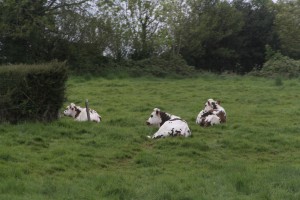I’ll be honest: I have a deep appreciation for cows and did not think that my travels to France would lead me to writing about them for one of my blog posts. I was born into a family that has maintained and operated an average-sized Ohio dairy farm through generations for the last seventy years or so. Cows are something constant I have been around my whole life. While I did not physically grow up on the farm, I spent a lot of time there and being able to go to grandma and grandpa’s and likewise, out to the barn, was a real treat growing up.
Because of being around the dairy farming culture growing up, I understand the business side of it in some capacity. Cows and the milk that they produce are necessary on a daily basis for millions of Americans (my family included) to make a living and also provide the products that many Americans like to fill their fridges and pantries with. The United States produces the most gallons of milk annually and will always remain an important piece of what makes up the American workforce.
Coming in second place in world annual milk production, the cows of France, and the Normandy area specifically, seem to tell a different story from my observations. Starting last semester, our class was studying the Normandy invasion one week and discussing a particular piece that involved families – and their animals – being in the direct battle line of the invasion. The number of cows alone lost during D-Day nears 100,000 and gives an indication of the toll the invasion took on livestock in Normandy. Losses aside, as we were discussing D-Day, the topic of “Happy Norman Cows” came up in class, and I was quite skeptical of just how happy they were at first. Although, the first time on the bus I saw a field of cows just laying around grass fields that stretched for miles and miles, soaking in the sun, gnawing grass to the soil, my skepticism instantly evaporated. These cows are genuinely ecstatic, excited, and all-around generally joyful. While the cows I’ve been around all of my life roam the fields, are always treated with care and with comfort, and are used in the right way, the animals are also valuable tools to producing product and therefore profit that helps put food on the table. In comparison, Norman cows live like animal royalty if there were distinctions for such things. I cannot recall ever seeing a cow smile, nor am I completely sure that they can, but I’m almost certain that I have seen it here (pictured right) in the French countryside. I did not get to see an actual French dairy farm, though I’m sure they are fairly similar to American farms in the way they operate. Nonetheless, the way American and French cows live are different, but that’s okay and interesting to see and compare.
As it relates to World War II, I did a small amount of research on the involvement of cows within Operation Overlord out of pure curiosity. While the results were slim, the information I got was superb. From the September 2, 1994 edition of the Free Lance-Star of Fredericksburg, Virginia, I found an article titled, “Normandy’s cows played curious role in WWII.” The opening two sentences give a clue-in to just how odd but fascinating their role was as it says: “The curiosity of Normandy cows could get a soldier killed or captured in the summer of ’44. If he were lucky, those natural – but neutral – animal allies could save his life.” Cows served various purposes in the operations. While the cows’ honest curiosity of the invading Americans in their area lead the animals to unintentionally give away allied positions, they also would stare at enemy German soldiers to within two-three meters, giving the allies across the field indication that the field held an enemy. Even more so, American soldiers used cow carcasses as bearings for when giving directions and orders to follow. The hedgerows in Normandy are tall and hard to navigate through, so using the carcasses was something that useful to point out that differentiated from the hedgerows to help navigate. The troops were entirely grateful for being able to use the fallen creatures.
Again, I never thought that traveling to France as part of our World War II trip would enable me to write about these furry, ginormous, milk-producing creatures, but in retrospect, I highly doubt that American soldiers rushing the beaches of Normandy thought that these same creatures would serve as bearing points, indicators of enemies ahead, or that a field hadn’t been mined because there were still cows trotting through it. From Eisenhower down to the lowly, neutral – but happy – Norman cow, every ally involved with the Normandy invasion played their part on the way to a successful operation.


